
Stonehenge
If you come by car and take off the A303 onto the A344, you get to see the first view of Stonehenge. Majestically they rise on slightly higher ground, where they already have stood for thousands of years. And those thousands of years make it worthwhile, to offer a couple of hours in getting there, if you are nearby. The stones have not the grace of the Parthenon in Athens - on the contrary, they are a simple, but mighty monument. In spite of that, or maybe just because of this, the impression is overwhelming. One must not forget that Stonehenge is about 2000 years older than the buildings on the Acropolis. That is, in comparison, about as long as we use our calender.
If you look at it that way, which is then the greater performance? Personally, I can't make a decision.
On a normal, a little rainy Thursday-afternoon in August there is, in spite of the many cars, enough space on the parking lot. But probably there is not enough space at the solstices. Then one can not only see the site, but also its astronomical function and the mystery of the place as well. This makes it even more interesting.
In the background on the picture to the right you see some of the burial mounds, which are found in big numbers in the surroundings of Stonehenge.
|
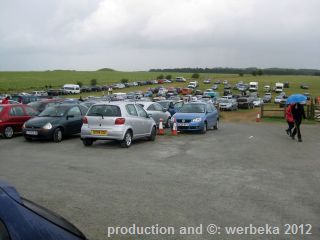
|
From the parking lot you come to the service center, where you can buy the tickets, lend an audio phone or get some souvenirs. Then you follow a tunnel - that leads under the A344 - in which you can behold paintings on the walls. They show scenes from the raising of the stones, respectively how the site probably had looked, when it was done.
Back on the surface you follow a bridge, which gets you over the mound and the moat - both are the earliest characteristics of Stonehenge. Both are dated until approximately 3000 BC.
Just a little outside the enclosure of the big monoliths is a circle of 56 holes, the Aubrey-holes.
|
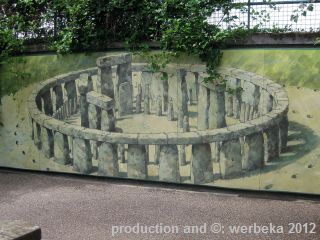
|
They are called after John Aubrey, who made the first notes about Stonhenge already in the 17th century. Probably the holes were used to steady the first wooden poles, which encircled the temple before the stones were used.
| Of course any trace of them is long gone.
There are two kinds of stones in Stonehenge - partly the big sarsen stones, which weigh up to forty ton, partly the smaller bluestones, of which the biggest have a weight of about five ton. The latter stand in the inner part of the sanctuary. The former ones had to be transported at least thirty kilometers. One believes, that twohundred people with the help of sleds and rolls could manage to transport one stone in twelve days. The bluestones are much lighter, but on the other hand they had to cover a distance of about 240 kilometers.
|
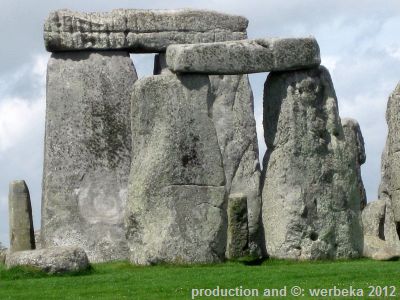
|
Through their composition it has been shown, that their origin is found in the Presli-Mountains in Wales. Presumably they were transported the most part of the distance on the water, namely the Bristol-Channel, which extends between Wales and Cornwall.
The perches have pegs on their upper sides, which fit into the holed cavities of the topstones. The topstones have furthermore a tongue and groove connection. In the picture to the right you can clearly see such a peg on the second stone from the left.
Originally - if Stonehenge ever was finished - thirty perches should build the circle.
|
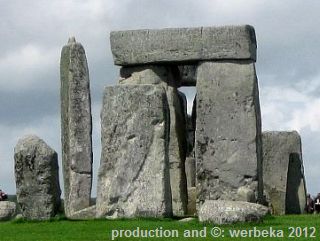
|
Today there are seventeen. It is also believed, that the bluestones were used as border of the site, before the big sarsen-stones were raised. It is assumed that they were fetched from another sanctuary, which was situated in Wales. But then isn't it a good guess, that the first people to build Stonehenge were emigrants from Wales?
|
The stones in the inner part of the sanctuary are worked better, so that they almost have the form of an even rectangle. The five original triliths in the center had been placed in a horse shoe formation. Also the smaller bluestones stood in geometrical forms. But those stones had been replaced frequently during the centuries, so that one can only guess, concerning their original standings. Regrettably in our days one isn't allowed to enter the inner part.
|
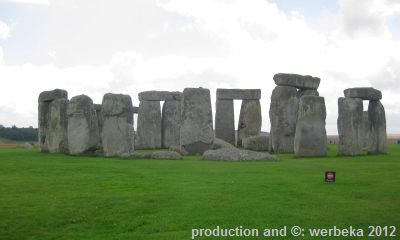
|
Because of that it is also rather difficult to closely show the formations in the inner part. This prohibition we owe to all the "artists", who think that they must "improve" a five thousand year old monument with their initials or similar stupidities - with the help of coloursprays or even with hammer and chisel!
The graffiti has been taken off, but some lichen has spread over just that area and so given the stone its yellow colour (picture to the right). By the way, the stones of Stonehenge are overgrown by many different kind of lichen, which are rather untypical for that area.
|
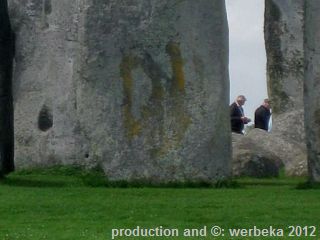
|
The best kept section consists of four perches and three topstones (picture to the right), at the Northeast side of the temple.
There are other stones within the site of Stonehenge, which are worth mentioning. For instance the Sacrificial stone, which has gotten its cruel name by mistake. It is a fallen perch, which is covered by cavities. The rainwater keeps in them, reacts together with the iron of the sarsen stone and turns red. That has - naturally - stimulated some phantasies ... The Sacrificial stone lies near the old "main entrance" to the temple.
|
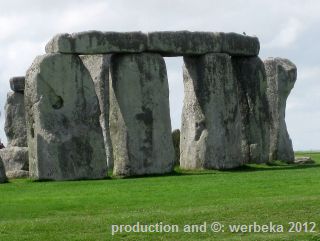
|
The so called Avenue leads to this main entrance, from all the way off the banks of the river Avon. It is not conceivable any more on the surrounding fields, though. There are also four Station stones - two of them can be seen today - which make a perfect rectangle, the center of which is also exactly the center of the sanctuary. Maybe they were used for calculation? Those people didn't really have either a computer or any pocket calculator close-by.
Finally there is the Heel stone (picture to the right), which, as well as the Sacrificial stone, is placed alongside the Avenue. The part of the Avenue, that is closest to Stonehenge, is constructed exactly in the line of the site's axis, so that the first rays of the summer solstice shine into the temple right over this street of cortege. Six months later the sun sets on the opposite side. This way it disappeared right in the opening of the biggest trilith, which stood in the middle of the temple.
|
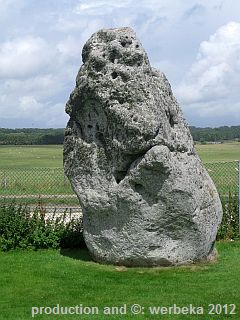
|
It is very possible, that the winter solstice was more important, because that meant, that the sun would shine longer again and that the days also would become longer. That was in the younger stone age utterly important for the people, at that time consisting of hunters and gatherers.
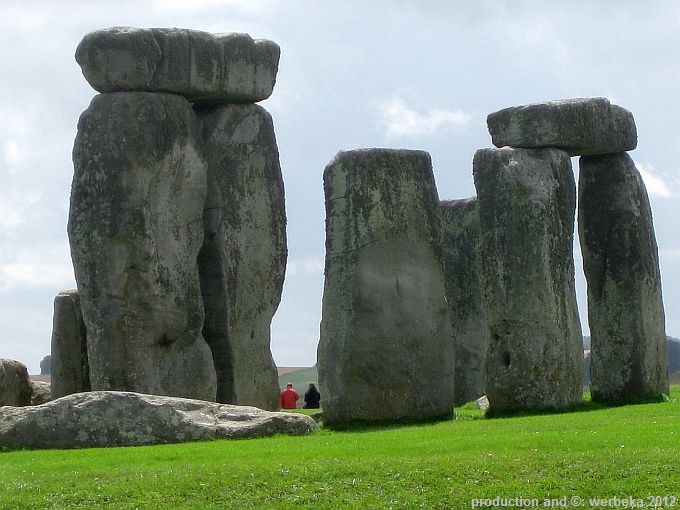
For coming to an end, here are some curiosities from modern times: in 1915 Stonehenge went on auction. A certain Cecil Chubb bought it for 6600 pound, but shortly thereafter donated the building to the people of England. Even if the site was fenced in for a shorter period already in 1901, it was later possible again, to enter the stone circle. That could be done until 1978 - but by then the number of visitors had risen that much, that new measures had to be found. Today around 850 000 visitors a year come to see to Stonehenge.
© Bernhard Kauntz, Wolvertem, Belgium 2012
Back to  or to the or to the  of of 
last update: 19.8.2012 by webmaster@werbeka.com
|











